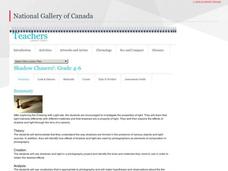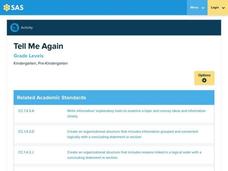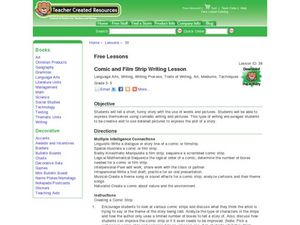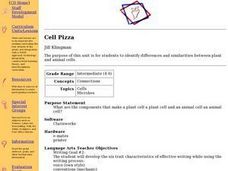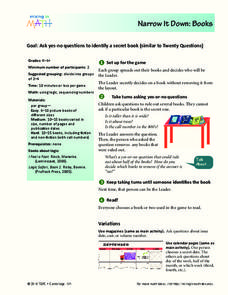For the Teachers
Story Strips Sequencing
What happens next? Work on story sequence with a lesson that prompts kids to put a story back in order. Additionally, they discuss what would happen if one event was missing from the sequence.
National Gallery of Canada
Shadow Chasers!
Experiment with light and shadow with a photography instructional activity. Learners first view several artistic photographs. They then play with different levels of light and various objects, eventually putting together compositions and...
Pennsylvania Department of Education
Tell Me Again
Students demonstrate how to retell a story in sequential order. In this reading comprehension lesson, students listen to a suggested read aloud, such as Little Boy Blue. Additionally, students practice retelling the story by using...
Arizona Department of Education
Introduction to Integers
Welcome to the backward world of negative numbers. This introductory lesson teaches young mathematicians that negative numbers are simply the opposite of positive numbers as they use number lines to plot and compare...
EduGAINs
Data Management
Using a carousel activity, class members gain an understanding of the idea of inferences by using pictures then connecting them to mathematics. Groups discuss their individual problems prior to sharing them with the entire class....
Curated OER
Activity Plan 4-5: Riddles by the Bagful!
Students write a riddle to be included in a class riddle book. In this creative-thinking lesson, the teacher will introduce children to riddles, then guide children through the process of writing and illustrating their own riddles to be...
Curated OER
The Beginning, The Middle, & The End
Cut magazine pictures into three sections, having your youngsters piece the pictures back together. With this fun activity, they discover the importance of sequencing a story. Then they use a fun template (shaped like a burger) to write...
Skyscraper Museum
Changes in a City Over Time
Investigate the growth and development of New York City with the final lesson in this four-part series on skyscrapers. Learners first explore the concept of urban growth by looking closely at a series of three paintings made of Wall...
Curated OER
The Very Hungry Caterpillar
Here is a good activity on butterflies and caterpillars. After listening to The Very Hungry Caterpillar, young learners put cards that depict the life cycle of a butterfly in the correct order. There are some good ideas for center...
Curated OER
Compound Inequalities and Graphing
Put geometry skills to the test! Learners solve compound inequalities and then graph the inequalities on a coordinate plane using their geometric skills. They identify the slope and y-intercept in order to graph correctly. I like this...
Curated OER
Sorting
Students examine the concepts of organization and classification. In this library skills lesson, students practice ordering and sorting skills by playing an interactive Internet game. Students then practice their classification skills in...
Curated OER
Sorting
Students examine the concept of organization. In this library skills lesson, students practice ordering and sorting skills by playing the Flood Game.
Curated OER
Alphabet Sideshow
Students practice sound and recognition of letters in alphabetical sequence. They gain an understanding of letter sounds and order. They create a slide show with graphics and text. They present their slide show to the class.
Curated OER
Geography Action! Rivers 2001- River Puzzle
Students cut out puzzle pieces and create a healthy river by putting the pieces together in a logical order on construction paper. Students begin by placing the "source" piece at the start of the river and the "mouth" piece at the end,...
Curated OER
Hop Into A Story
Students listen to the story "Tuesday," and discuss all of the elements that made this story. In this language instructional activity, students tell the story of "Tuesday," (which is all pictures, no words), as the teacher turns the...
Curated OER
Drafting
Students use transitions to connect the beginning, middle and end of their writing. In this lesson on drafting a story, students use a graphic organizer sandwich to put pictures back together and recognize a specific order.
Curated OER
Explore Chapters 1 - 5
Students preview the novel, "Dragonwings," by Laurence Yep, make connections between the novel previewed and their prior knowledge, other texts, and the world. They utilize graphic representations including charts, graphs, pictures, and...
Curated OER
Zero is Our Hero
Students practice counting sets of items by 10's. In this counting lesson, students create flash cards that show a zero while hiding the first number in order for students to practice counting by 10's. Students practice...
Curated OER
Something From Nothing
Students listen to story Joseph Had A Little Overcoat to explore people from another culture and how one item can be used to make other items; students use scraps of fabric and other knickknacks to create pictures or toys.
Curated OER
Getting to Know You
Students converse with each other while playing a game in order to discover things that are alike and things that are different about themselves. The students gather data about themselves, organize and display data on the graph, and...
Curated OER
Comic and Film Strip Writing
Students write a funny story and illustrate it in a comic strip. In this comic strip lesson, students study comic strips and determine the plot of each story. Students then write a short story and illustrate it using a comic strip...
Curated OER
Cell Pizza
Students identify parts and functions of microscope. Students watch video, Cells and Life about cell parts with actual pictures and actual cells. Students discuss video and identify parts of the cells that animals and plants have in...
Curated OER
An Encyclo-ME-dia for Every Child
Learners create a digital scrapbook that shows information-text and pictures that are specific to each child. They make charts and graphs. They use digital cameras, scanners, software, to write captions, stories, poems, letters, and...
Curated OER
Narrow It Down: Books
Students ask yes-no questions to identify a secret book. In this asking questions lesson plan, students ask yes or no questions about books to identify a secret book. Students identify the book and then read one of the example books.

